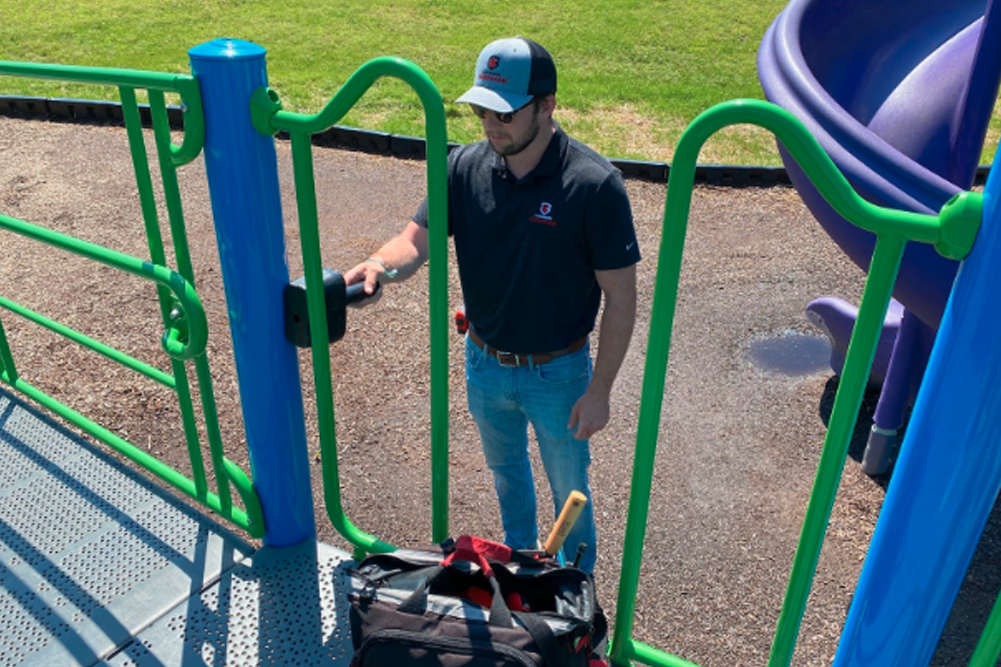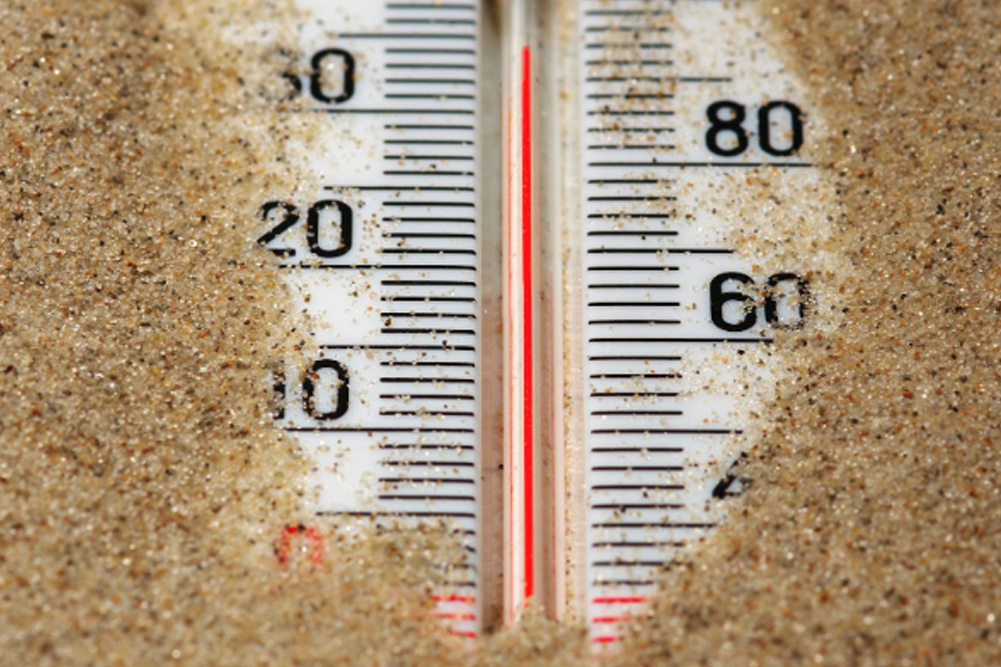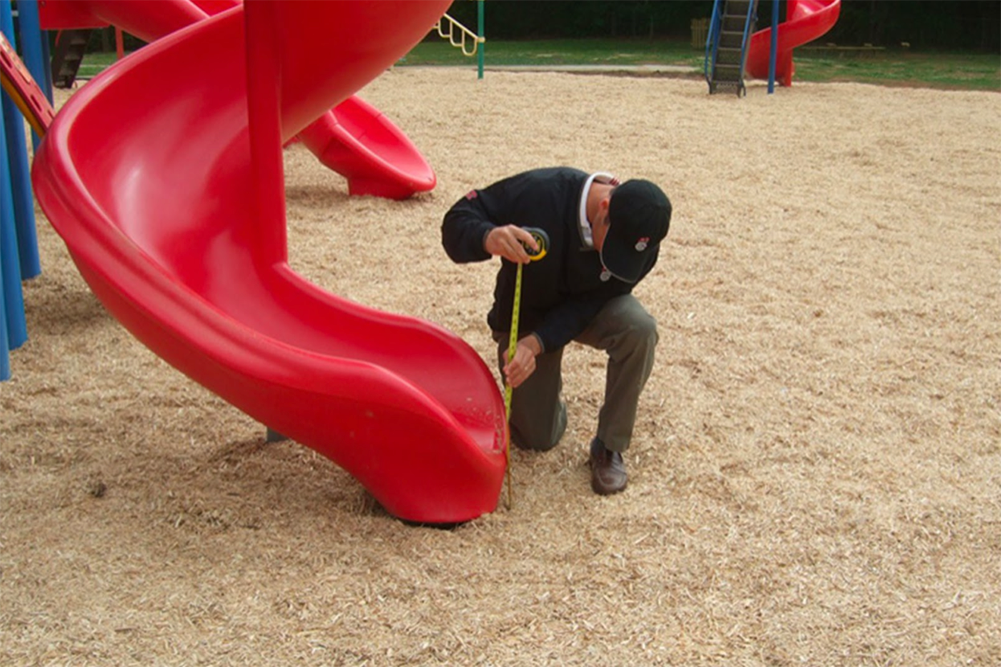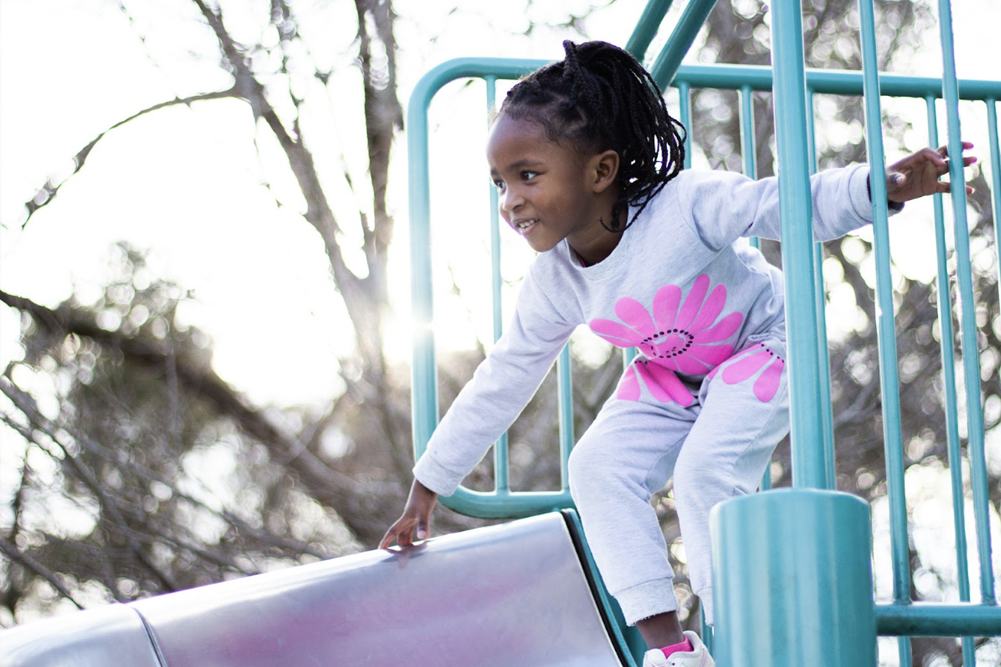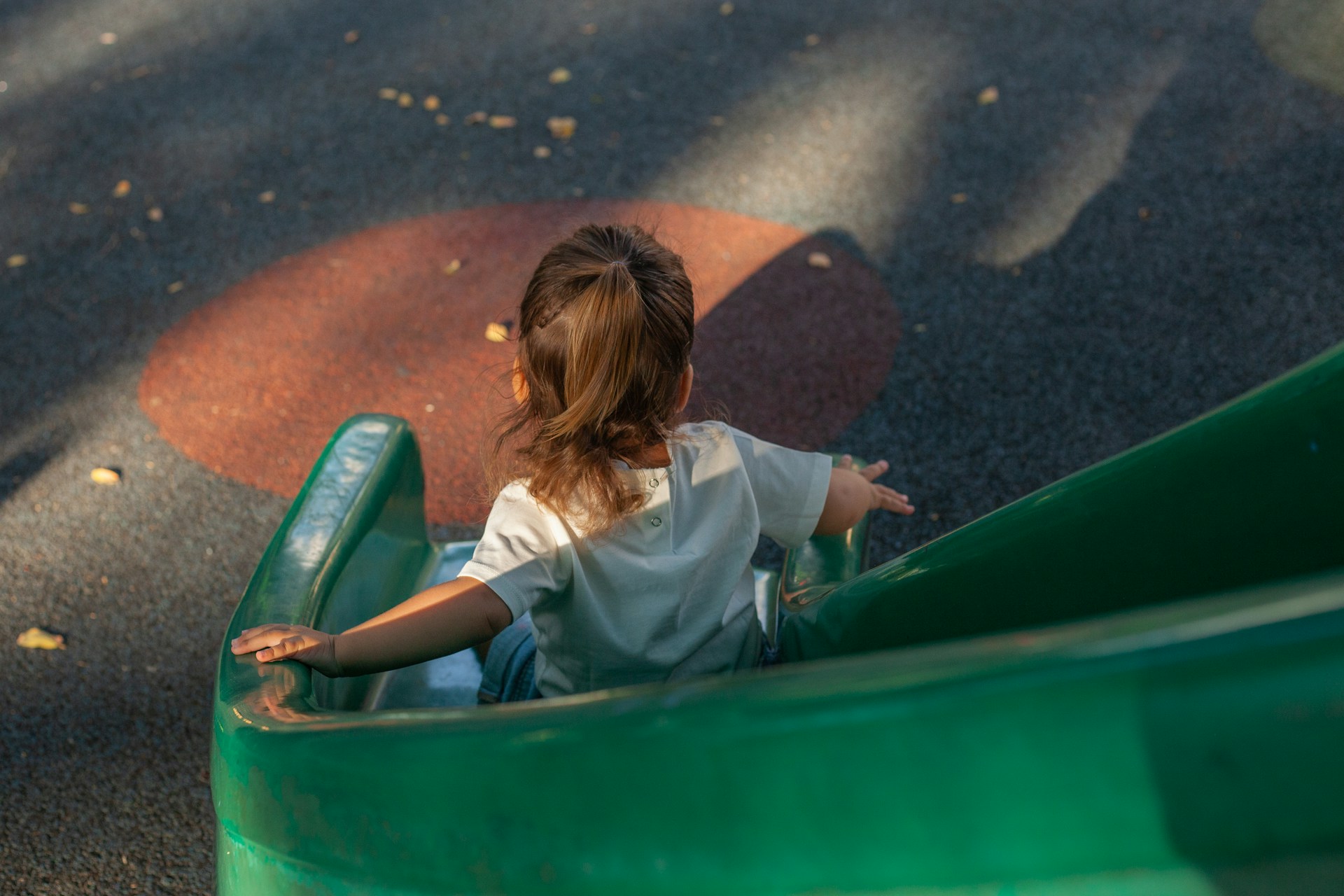As a certified park inspector, it's important to ensure the safety of all park visitors, especially children who use playground equipment. Playground equipment is a critical component of any community park, providing a safe place for children to play, exercise and learn critical social skills. However, even the best playground equipment can wear out over time, leading to potential hazards and injuries. In this blog post, we'll discuss the top 10 signs that your community playground may need to be inspected or replaced, including:
- Age of the Equipment
- Why Does the Age of Playground Equipment Matter?
- What is the Average Lifespan of Playgrounds & Playground Equipment?
- Visible Damage
- How is Visible Damage Assessed During a Playground Inspection?
- earWear and Tear
- What Kind of Wear and Tear Should You Look for When Inspecting a Playground?
- Loose or Broken Parts
- How Often Should You Inspect Swings, Ropes, Chains and Slides on a Public Playground?
- Trip and Fall Hazards
- What Should You Look for When Inspecting Trip and Fall Hazards on a Playground?
- Faded or Missing Safety Signs
- What is a Playground Safety Sticker?
- How Often Should You Replace Playground Safety Stickers?
- Where Can You Replace Your Playground Safety Stickers?
- Excessive Wobble
- How Do You Inspect a Playground for Wobbling or Instability?
- Inadequate Drainage
- How Do you Eliminate Standing Water or Slippery Surfaces on a Playground?
- What Kind of Drains Can Be Installed on Playgrounds?
- Lack of Accessibility
- Why is It Important to Have an Accessible Playground?
- Can You Be Fined if Your Playground Isn’t Accessible or ADA Compliant?
- Outdated Design
- What Playground Designs are Considered Outdated?
Age of the Equipment
One of the most common reasons for playground replacement is the age of the equipment. Playground equipment has a lifespan, and if it has not been replaced in a while, it's time to schedule an inspection or consider replacing it.
Why Does the Age of Playground Equipment Matter?
The age of playground equipment matters because like any other man-made structure, it can deteriorate over time due to various factors such as weather, wear and tear, and vandalism. As a result, older playground equipment may pose safety risks to children who use it.
Playground equipment has a limited lifespan due to the constant exposure to the elements, the physical stress of children playing on it, and the regular wear and tear from regular use. With time, metal structures may rust, wooden structures may rot, and plastic structures may crack, leading to weakened and unsafe equipment.
In addition to the physical deterioration, older playground equipment may not meet current safety standards and may lack the latest safety features, making it more dangerous for children to play on. For instance, older equipment may have sharp edges, exposed bolts, or rusty joints that can cause injury to children, while newer equipment is designed to minimize potential hazards.
Older playground equipment is more prone to safety hazards, lacks the latest safety features, and requires more frequent repairs and maintenance.
What is the Average Lifespan of Playgrounds & Equipment?
The average lifespan of playground equipment depends on various factors, including the quality of the equipment, the materials used, the level of use, and the maintenance and inspection schedule. However, most industry experts estimate the average lifespan of playground equipment to be around 10 to 15 years.
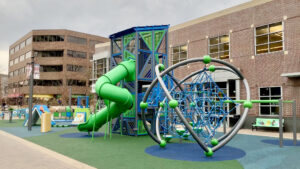
This estimated lifespan assumes that the equipment is made of high-quality materials, such as powder-coated steel or high-density polyethylene, and has been installed correctly. It also assumes that the equipment is used and maintained properly, and regular inspections are carried out to detect and address any signs of damage or wear and tear.
It's important to note that this estimated lifespan is just a guideline and that the actual lifespan of playground equipment can vary significantly. Equipment in coastal areas, for example, may have a shorter lifespan due to exposure to salt and moisture in the air. Likewise, playgrounds in areas with extreme weather conditions may require more frequent repairs and maintenance.
Visible Damage
Any visible damage to playground equipment can indicate that it's not safe for use. Look for cracks, rust, sharp edges, splinters, loose bolts, or other visible damage that may indicate that the equipment is not safe to use.
How is Visible Damage Assessed During a Playground Inspection?
During a playground inspection, visible damage is assessed by visually examining all components of the equipment to check for any signs of damage or wear and tear. The inspector will look for a variety of visible issues, such as:
Cracks or Breaks: Inspectors will look for cracks or breaks in any part of the equipment, including the support structures, steps, platforms, and railings. Any visible cracks or breaks can indicate that the equipment is structurally unsound and poses a safety risk.
Rust or corrosion: Inspectors will check for signs of rust or corrosion on metal components of the equipment. Rust can weaken the metal and compromise its structural integrity, making it more likely to fail or break.
Sharp edges or corners: Inspectors will look for any sharp edges or corners on the equipment that could cause injury to children.
Splinters: Inspectors will check for splinters on wooden equipment. Splinters can be painful and may even lead to infection.
Loose or missing bolts: Inspectors will check all bolts and fasteners on the equipment to ensure they are properly secured. Loose or missing bolts can cause instability and compromise the safety of the equipment.
Faded or worn surfaces: Inspectors will check for any surfaces that are faded, worn, or otherwise damaged. These surfaces can be slippery, making it more likely for children to fall or slip.
Mold or mildew: Inspectors will check for mold or mildew on any part of the equipment. Mold can cause health problems for children, and mildew can weaken the structure of the equipment.
If visible damage is found during the inspection, the inspector will recommend that the equipment be repaired or replaced as necessary to ensure that it is safe for children to use. By identifying visible damage early on and taking corrective action, playground owners can help prevent accidents and keep children safe.
Wear and Tear
Check for excessive wear and tear on equipment, such as peeling paint, worn or missing parts, or fading colors. These may affect the functionality of the equipment and pose a safety risk.
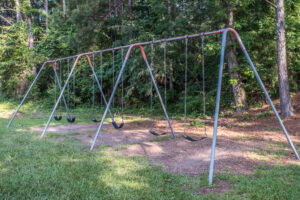
What Kind of Wear and Tear Should You Look for When Inspecting a Playground?
Weathering: Playground equipment is exposed to the elements, including sun, rain, and snow, which can cause fading, rusting, and corrosion. Over time, weathering can weaken the equipment and compromise its structural integrity.
General Use: Regular use by children can cause wear and tear on playground equipment. For example, swings and slides can wear down over time, and climbing structures can become loose or unstable.
Vandalism: Unfortunately, vandalism is a common issue for playgrounds. Graffiti, broken equipment, and other forms of vandalism can cause damage to playground equipment, making it unsafe for children to use.
Aging: As playground equipment ages, it can become more prone to wear and tear. For example, wooden structures can rot over time, and metal structures can become rusty and weakened.
Chemical exposure: Exposure to chemicals, such as cleaning agents, can cause damage to playground equipment. Chemicals can cause discoloration, cracking, and other types of damage.
Improper maintenance: Playground equipment requires regular maintenance to keep it in good condition. Improper maintenance, such as neglecting to lubricate moving parts or failing to tighten bolts and screws, can cause damage to the equipment and compromise its safety.
Loose or Broken Parts
Any loose or broken parts on equipment such as chains, ropes, swings, or slides can cause accidents and injuries.
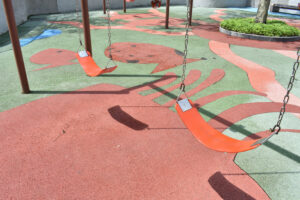
How Often Should You Inspect Swings, Ropes, Chains and Slides on a Public Playground?
Swings, ropes, and chains are some of the most frequently used and popular components of public playgrounds. As such, it is crucial to check them regularly to ensure that they are safe for children to use.
Check daily: Swings, ropes, and chains should be checked daily for signs of damage or wear and tear. Any visible signs of damage, such as cracks, rust, or fraying, should be addressed immediately.
Check after inclement weather: After heavy rain or strong winds, it is recommended to check the swings, ropes, and chains for any damage or loosening that may have occurred due to the weather.
Check during routine inspections: Playground equipment should undergo routine inspections by a certified inspector at least once a year. During these inspections, swings, ropes, and chains should be thoroughly examined for any damage or wear and tear that may have occurred.
Follow manufacturer's recommendations: The manufacturer of the playground equipment should provide recommendations for maintenance and inspection. It is important to follow these guidelines to ensure the safety and longevity of the equipment.
Keep records: It is recommended to keep records of all inspections and maintenance activities performed on the swings, ropes, and chains. This can help identify patterns of wear and tear and ensure that the equipment is properly maintained over time.
Trip and Fall Hazards
Potential trip and fall hazards can be found in many areas of a playground. Inspecting for trip or fall hazards on a playground is an essential part of maintaining a safe play environment.
How to Inspect for Trip or Fall Hazards on a Playground
Check for uneven surfaces: Inspect all surfaces of the playground, including the ground, walkways, and steps, for any uneven surfaces that could cause a child to trip or fall. Look for cracks, holes, or raised edges that could cause a child to stumble.
Look for tripping hazards: Check for any objects or debris that could pose a tripping hazard. This could include tree roots, rocks, or toys left on the ground.
Inspect stairs and handrails: Check stairs and handrails for any signs of wear and tear, including loose or missing handrails, loose bolts or screws, or uneven steps. Ensure that all stairs and handrails are securely fastened.
Check for gaps: Look for gaps in equipment, such as between the ladder rungs or the steps of a slide, that could trap a child's foot or cause a child to trip.
Check for sharp edges: Inspect equipment for any sharp edges or corners that could cause a child to injure themselves if they fall against them.
Check for proper surfacing: Ensure that the playground has appropriate safety surfacing in place, such as rubber mulch, wood chips, or sand, to cushion falls and reduce the risk of injury.
Consider the age group: Keep in mind the age group of children who will be using the playground when inspecting for trip or fall hazards. Younger children may be more prone to tripping and falling, so extra care should be taken to ensure that the playground is safe for their use.
By regularly inspecting for trip or fall hazards on a playground, owners can help ensure that children can play safely and enjoyably without the risk of injury. Any hazards identified during the inspection should be addressed immediately to ensure the safety of the children who use the equipment.
Faded or Missing Safety Signs
Safety signs are essential for informing visitors of the proper use and potential risks associated with the equipment. If they are missing, faded, or illegible, the playground may not be safe for use.
What is a Playground Safety Sticker?
A playground safety sticker is a label or decal that is affixed to playground equipment to provide important safety information and guidelines for children and caregivers. These stickers typically contain messages that promote safe play and encourage children to follow certain rules and guidelines while using the equipment.
How Often Should You Replace Playground Safety Stickers?
The frequency of replacing playground safety stickers may vary depending on various factors, including the amount of sunlight, humidity, and other environmental conditions that the stickers are exposed to, as well as the frequency of use and the age of the equipment. A general recommendation is to replace the stickers at least once a year, during routine playground maintenance and inspection.
During the annual inspection, playground owners and operators should check the condition of all safety stickers and signs, including the age, visibility, and legibility of each sticker. If the stickers are faded, damaged, or illegible, they should be replaced immediately. Additionally, if any new safety hazards have been identified since the last inspection, new stickers or signs may need to be added to address these hazards.
Where Can You Replace Your Playground Safety Stickers?
If you need to replace your playground inspection and safety stickers, Playground Guardian can help!
First, you will need to identify the areas of your playground where the existing stickers need to be replaced. This may involve conducting a thorough inspection of the equipment and identifying any areas that require attention.
Once you have identified the areas that need new stickers, you can order the playground inspection stickers from Playground Guardian's website or by contacting us today.
Excessive Wobble
Playground equipment that wobbles excessively or has too much movement may indicate structural damage or wear and tear.
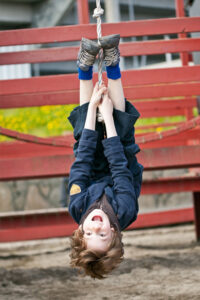
How Do You Inspect a Playground for Wobbling or Instability?
Check the footing: Start by checking the footing of the playground equipment. Make sure that the equipment is level and that the footing is secure. Look for any signs of erosion or movement around the base of the equipment.
Look for loose connections: Check all of the connections on the equipment, including bolts, nuts, and screws. Make sure that they are tight and secure. If you find any loose connections, tighten them or replace the hardware as needed.
Inspect the frames: Look at the frame of the equipment and check for any signs of bending, warping, or other damage. Make sure that the frame is sturdy and can support the weight of multiple users.
Check the supports: Look at the supports for the equipment, such as poles or beams. Make sure that they are straight and that there are no signs of bending or warping.
Test the equipment: Finally, test the equipment by pushing and pulling on it to see if it wobbles or moves. If you notice any wobbling or instability, try to identify the source of the problem and address it as soon as possible.
Inadequate Drainage
Inadequate drainage can lead to standing water, which can make playground equipment slippery and hazardous, especially during colder months.
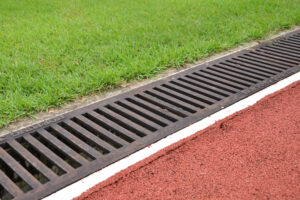 How Do You Eliminate Standing Water and Slippery Surfaces on a Playground?
How Do You Eliminate Standing Water and Slippery Surfaces on a Playground?
Proper Drainage: Ensure that the playground has proper drainage systems that channel water away from the play area. This may involve installing drains, swales, or grading the area to create a slope that directs water away from the playground.
Surface Materials: Choose non-slip and non-porous surface materials that allow for water to drain easily, such as rubber mulch, engineered wood fiber, or artificial turf.
Regular Cleaning: Regularly clean the playground surfaces, especially after rainfall or heavy use, to prevent the buildup of mud, algae, or other substances that can cause surfaces to become slippery.
Additions: Consider adding additional features such as canopies, shelters, or shade structures to protect the playground from the elements, preventing water from pooling and helping to keep surfaces dry.
What Kind of Drains Can Be Installed on Playgrounds?
There are several types of drains that can be installed on playgrounds to help eliminate standing water and prevent slippery surfaces. Here are some common types:
Trench Drains: Trench drains are long, narrow drains that are installed at the edge of the play area to collect water and channel it away from the playground. They can be made of various materials, such as concrete or polymer, and can be covered with a grate or slotted cover to prevent debris from entering.
French Drains: French drains are underground drainage systems that use a perforated pipe surrounded by gravel or rock to collect and channel water away from the playground.
Catch Basins: Catch basins are drainage systems that are installed below ground level and are used to collect and store water before it is channeled away from the playground. They can be made of various materials and can be covered with a grate or slotted cover to prevent debris from entering.
Swales: Swales are natural or constructed channels that are designed to direct water away from the playground. They can be filled with vegetation or rocks to slow down the flow of water and prevent erosion.
Surface Drains: Surface drains are channels or pipes that are installed on the surface of the playground and are designed to collect and channel water away from the play area.
Lack of Accessibility
If the playground is not accessible to all visitors, it may need to be replaced or updated to comply with ADA regulations. Having an accessible playground is important because it allows children of all abilities to play together, promotes inclusivity, and provides equal opportunities for physical activity and socialization.
Why is It Important to Have an Accessible Playground?
An accessible playground is crucial for promoting inclusivity, providing equal opportunities for physical activity and socialization, and reducing the stigma associated with disabilities. Compliance with legal requirements, such as the Americans with Disabilities Act, is also important for avoiding legal issues and ensuring that facilities are welcoming to all. Additionally, an accessible playground can be good for business by attracting a wider range of customers and increasing revenue.
Can You Be Fined if Your Playground Isn’t Accessible or ADA Compliant?
Yes, it is possible to be fined if your playground is not accessible or ADA-compliant. The Americans with Disabilities Act (ADA) requires that all public playgrounds be accessible to children with disabilities, and failure to comply with these regulations can result in legal consequences. In some cases, a complaint may be filed with the Department of Justice or a private lawsuit may be initiated. If found in violation of ADA requirements, fines and penalties may be imposed. Additionally, non-compliance can result in negative publicity and damage to the reputation of the playground owner. Therefore, it is important to ensure that your playground is accessible and meets all applicable regulations.
For more information on how to make your playground ADA accessible, please visit our blog.
Outdated Design
Playgrounds should be designed to provide safe and engaging play experiences. If the design is outdated, it may not be as safe as newer models.
What Playground Designs are Considered Outdated?
There are a few playground designs that may be considered outdated, especially in terms of safety and accessibility for children of all ages and abilities. The design of playgrounds has evolved to prioritize safety, accessibility, and engaging play opportunities for children. While some older playground designs may still exist, they may not meet current safety standards and may need to be updated or replaced. Here are some playground features that are considered dated:
Tall and narrow structures: Traditional playground designs often included tall and narrow structures, such as monkey bars and high slides. However, these structures can be dangerous if children fall from a significant height. Additionally, they may not be accessible to children with mobility issues or physical disabilities.
Hard surfaces: Older playgrounds often had hard surfaces, such as concrete or asphalt, which can be dangerous if a child falls. Nowadays, most playgrounds have softer surfaces, such as rubber or mulch, to provide a cushioned landing.
Limited play options: Older playgrounds often had limited play options, such as swings and a slide. However, modern playgrounds often include a variety of play equipment, such as climbing walls, tunnels, and interactive features, to engage children and promote physical activity.
Lack of shade: Playgrounds that lack shade can be uncomfortable and even dangerous for children, especially during hot summer months. Modern playgrounds often incorporate shade structures, such as canopies or umbrellas, to provide a cooler and safer play environment.
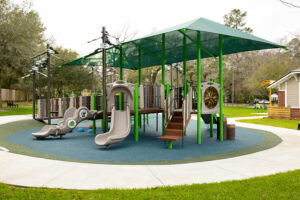
Regular inspections and maintenance of playground equipment are essential for ensuring the safety of all visitors. As a certified park inspector, it's crucial to be vigilant in identifying potential hazards and recommending necessary repairs or replacements. By keeping a watchful eye on the signs outlined above, you can help keep your community's playgrounds safe and enjoyable for everyone.
How Playground Guardian Can Help
Playground Guardian can help ensure that your playground is up to date and in code to pass inspections and keep your community happy in several ways.
Playground Guardian provides safety inspections and playground maintenance services that are tailored to the specific needs of your playground. This includes a detailed inspection report that identifies any safety hazards, compliance issues, or maintenance needs, along with recommendations for corrective action.
Playground Guardian also offers comprehensive playground services to help ensure that your play area is safe and compliant with all applicable regulations. This includes safety audits, risk assessments, compliance evaluations, and hazard remediation services.
Playground Guardian can help you stay up to date with the latest safety standards and regulations by providing ongoing playground inspection education and training for your staff and volunteers. This can include workshops, seminars, and webinars on topics such as playground safety, maintenance, and risk management.
If you wish to manage your playground independently but still want to ensure that you are adhering to the latest codes and assessments, Playground Guardian provides a tailored playground software called Park Protector. This software guides your staff through a comprehensive playground inspection with ease.
For more information on our services or to schedule a free consultation, contact us today!

